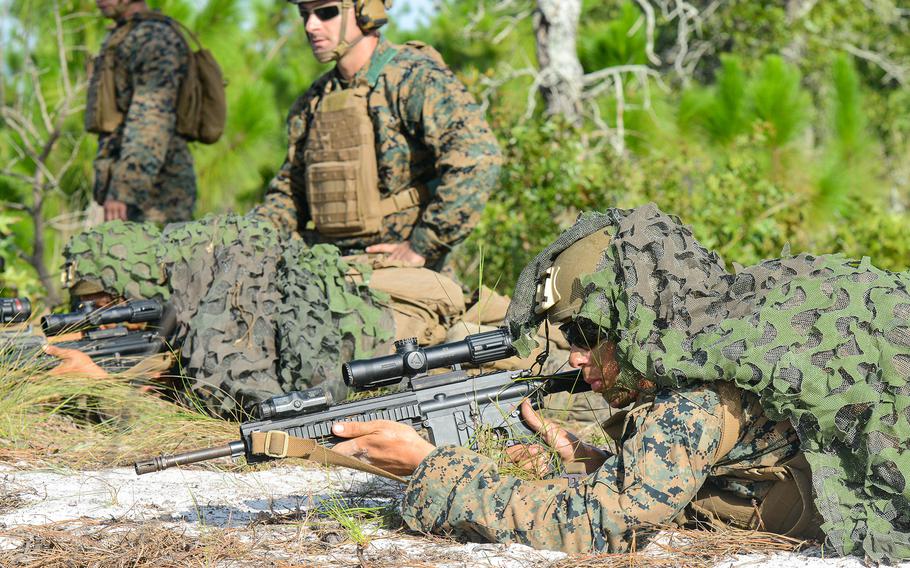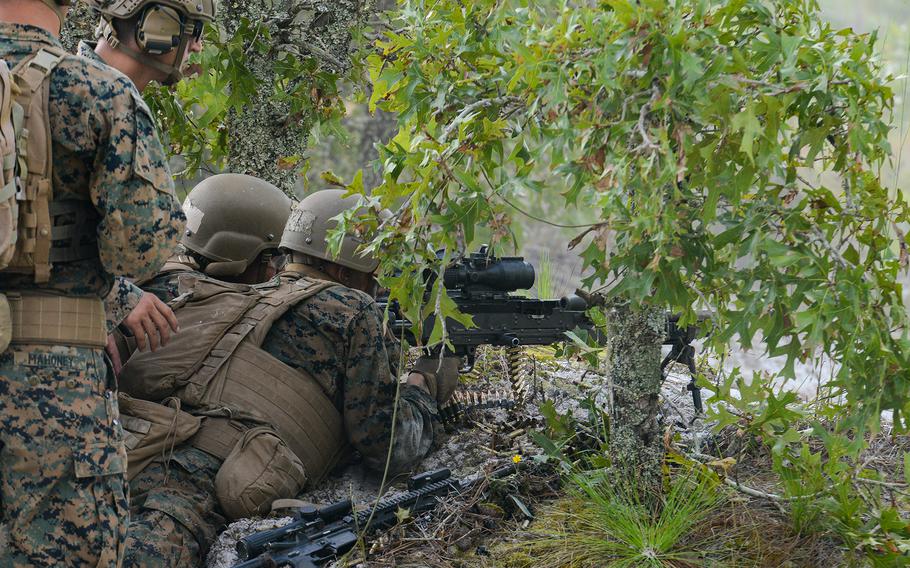
Marine infantry students at Camp Lejeune, N.C., practice setting up an ambush, as their instructor looks on, in a live-fire training event Aug. 27, 2021, during their 12th week of initial infantry training as part of a pilot program meant to drastically change the way the Corps trains its infantrymen. The pilot program expands infantry training from nine to 14 weeks and places Marines in 14-person squads under a single instructor. (Corey Dickstein/Stars and Stripes)
CAMP LEJEUNE, N.C. — Marine Corps leaders have their eyes on the kind of combat that a war against an adversary such as China or Russia could bring, and they are training their troops to be prepared for that fight by building better-thinking, more well-rounded infantrymen capable of operating in small units with little oversight.
The Corps wants to create infantrymen who will arrive at their first duty station with the critical and creative thinking skills of Marines several years into their career, instead of the robot-like, trigger-pullers that some have accused the service of producing in its longstanding entry-level infantry course, Marine officials said last week.
At Camp Lejeune, N.C., the Corps’ School of Infantry-East is attempting to make those changes, experimenting with a new initial infantry training program that lasts longer, includes more face-to-face time with instructors, and challenges green infantrymen on more difficult skills, said Col. David Emmel, the school’s commander.
“The Marine Corps is going through very large changes … and we are one element of that within the larger service’s efforts,” Emmel told reporters Aug. 27 at Camp Lejeune, as the first group of 194 Marines neared completion of the School of Infantry-East’s first attempt of the new training program, known as the Infantry Marine Course. “That’s making a more lethal, smarter, more elite Marine infantryman — Marines with a strong moral foundation, who are grounded in the Marine Corps ethos, who possess the skill and the will to succeed in the future operational environment. And, as part of that, the critical thinking which allows him [or her] to be adaptive in that environment.”
Those changes have been driven by the vision of Marine commandant Gen. David Berger — who, since becoming the top Marine in 2019, has instituted an overhaul of the service aimed largely at checking Chinese power in the Indo-Pacific region, where he believes his troops will need to work more closely with the Navy and in smaller units to compete with China’s forces. As commandant, Berger has axed the Marines’ tank units, urged Congress to shrink its force size and instructed units to prepare its youngest Marines to make tough battlefield decisions without a higher command’s input.

Marine infantry students at Camp Lejeune, N.C., practice setting up an ambush, as their instructors look on, in a live-fire training event Aug. 27, 2021, during their 12th week of initial infantry training as part of a pilot program meant to drastically change the way the Corps trains its infantrymen. The pilot program expands infantry training from nine to 14 weeks and places Marines in 14-person squads under a single instructor. (Corey Dickstein/Stars and Stripes)
At Camp Lejeune, Marine instructors are preparing some of the Corps’ newest infantrymen for just that operating environment in the Infantry Marine Course pilot program, which expands initial infantry training from nine weeks to 14 weeks. It marks the second use of the new program, which began with a course at the Marine’s School of Infantry-West at Camp Pendleton, Calif.
The new course puts new Marines in the field for about nine weeks, practicing critical infantry skills, fighting each other in force-on-force battles, and training them on advanced weapons that those who have completed traditional Marine initial infantry training have not been exposed.
But the most critical change to the course is how instructors work with their students, Emmel and other officials said.
The new model pairs a single combat instructor — an experienced infantry noncommissioned officer trained to teach new Marines — with a squad of 14 Marines, who the instructor is charged with overseeing, teaching and mentoring throughout the entire course. For decades, instructors taught Marines in infantry school in large groups, 80 to 200-plus Marines at a time, officials said.
Sgt. Jonathon Ritter, a combat instructor in charge of one of the Infantry Marine Course squads, said he has gotten to know his trainees much better during the pilot course than when he has taught in previous iterations of initial infantry training. The one-on-one time allows him to better understand how his students learn, what they respond to and how they react to challenges. His young Marines have advanced quicker than those he has taught in the traditional class, he said.
“Their development is actually exceeding a lot of our expectations,” Ritter said. “I took them from Day 1 where they couldn’t do any infantry skills, and then now to see them on the live-fire ranges, being able to execute, use their weapons for the right target without any [instructor] supervision — that’s extremely rewarding.
“A lot of the stuff they’re learning now is stuff that Marines [who are] traditionally one or two years into the fleet learn, and here we have them learning this stuff at entry level training. That’s huge.”
An ambush
The blast from the Claymore mine shot a cloud of smoke billowing dozens of feet into the air. From positions concealed by trees just beyond the mine’s reach, 14 young Marines opened fire with M27 rifles and M240B machine guns.
In minutes, the smoke cleared and the firing ceased. The enemy — robotic targets outfitted in camouflage — had been defeated. For the squad of freshly minted Marines about 12 weeks into the new Infantry Marine Course, the brief live-fire operation was the culmination of a week focused on sharpening the planning and tactical skills that go into executing an age-old combat tactic — an ambush.
For those leading the Marines, it was verification of the new efforts.
The squads each planned their ambushes on their own without their instructors’ input after spending the week learning the tactics that go into planning an ambush and practicing without live ammunition, said Marine Capt. David Allen, the commander of the School of Infantry’s Echo Company, which is conducting the pilot course. Combat instructors then tagged along as the squads conducted their ambushes, offering the occasional pointer, but allowing the Marines to make — and hopefully — learn from their own mistakes, Allen said.
One squad after another on Aug. 27 ran through the exercise on the sandy, wooded training grounds. Some groups executed near-perfect ambushes, Allen said. Others struggled.
In at least one iteration, a Marine’s M240B machine gun jammed, likely because it had not been cleaned well enough before the attack, his instructor said. In another, Marines set their mine off too early, failing to injure any enemy targets. In another ambush, some of the Marines set themselves up in positions where they were ultimately unable to see the enemy targets as they entered the “kill box,” another instructor said.
Despite the shortcomings, none of the Marines were chewed out. Combat instructors rarely yelled, except over the roar of gunfire. Young Marines held their heads high, as their instructors went over what they had done right and wrong just minutes after completing the mission. The Marines asked questions, and they prepared to run ambushes again.
“They're more willing to approach you, ask a question, more willing to engage in the training and just learn,” said Sgt. Govan Walcott, a combat instructor leading one of the 14-man squads in the pilot. “We’re not yelling. We’re here to instruct, to teach and then let them learn it their way and then go out and execute what it is that we’re trying to teach.”
‘Not just idiots’
Traditionally, a new Marine infantrymen — a boot, in Marine slang — will arrive at his or her first station with an elementary understanding of infantry tactics and spend the next two or more years learning how to actually operate from unit leaders, Walcott said.
The pilot program is designed to provide boot Marines to the Corps’ infantry battalions nearly ready to fight on the first day.
“We’re speeding up the timeline,” said Emmel, the School of Infantry-East commander.
For the instructors, it takes a shift in mindset. Walcott, who enlisted in 2015, said his instructors at the School of Infantry-East would tell him exactly what to do and when to do it. In the pilot program, instructors explain to students an outcome they want out of a scenario and let the new Marines find their own paths to that result.
“We’re looking at it like, hey, these are not just idiots, you know. These are individuals who can actually think and operate on their own and operate as a unit,” Walcott said. “So it’s — I'm going to give you this knowledge. Let me see how you apply it. And, the way you apply it actually might be somewhat of a different train of thought than I would have had. It might even work better.”
Walcott and other instructors said the pilot course was proving beneficial to the new Marines. He said he believed the Corps should adopt the training, which Corps brass will consider later this year after running at least two more pilot courses, one each at Camp Pendleton and Camp Lejeune.
Unlike infantry Marines who graduate traditional initial infantry training, those who complete the pilot program will have learned to shoot Javelin anti-tank missiles, fire machine guns, and use other weapons that new riflemen usually would not be trained to do.
The decision to incorporate more advanced weapons than just the M27 Infantry Automatic Rifle comes as the Corps considers merging all infantry jobs into a single military occupational specialty. That decision is yet to be made, a Marine spokesman said Tuesday.
Training Marines to use multiple weapons systems is a major advantage on the battlefield, Walcott said, adding he had never been exposed to some of the weapons, including the Javelin before becoming an instructor.
“These guys are definitely more trained up, so it wouldn't take as long to spin them up” at their first unit, he said. “And, then these guys are going to bring skills to the fleet that are not there right now.”
The pilot model is also more demanding on the instructors, Walcott and Ritter admitted. Their days often last from sun up to sun down and occasionally well into the night, they said. Nonetheless, they said those challenges were worthwhile.
An influx of new instructors would also be needed to adopt the Infantry Marine Course pilot program as the Corps’ initial infantry training program, officials said. Emmel said the East Coast and West Coast infantry schools were working with Marine headquarters to determine how large a cadre was possible, but he declined to provide a specific number of additional instructors he would require.
Those figures could change as the pilot course is adjusted based on feedback from the first two iterations, he added. Even the number of weeks could be changed.
Nonetheless, Emmel and other School of Infantry officials endorsed the pilot program as sending the Corps in the right direction for the future.
“We're giving the fleet more lethal Marines,” Emmel said.